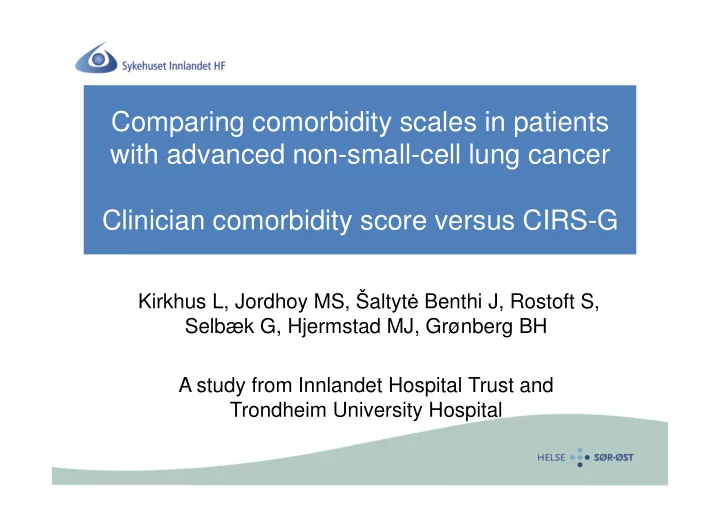

Comparing comorbidity scales in patients with advanced non-small-cell lung cancer Clinician comorbidity score versus CIRS-G Kirkhus L, Jordhoy MS, Šaltyt � Benthi J, Rostoft S, Selbæk G, Hjermstad MJ, Grønberg BH A study from Innlandet Hospital Trust and Trondheim University Hospital
Background • Comorbidity is an independent prognostic factor for survival in cancer patients 1,2 • In general, comorbidity increases with age 3 • A growing population of elderly cancer patients 4 • Systematic comorbidity assessments are needed 1. Firat S et al. Int J Radiat Oncol Biol Phys 2002 2. Marventano S et al. Int J Colorectal Dis 2014 3. Jansen-Heijnen ML et al. Lung cancer 1998 4. Syse A et al. Norsk Epidemiologi 2012
The Cumulative Illness Rating Scale for Geriatrics (CIRS-G) - Frequently used and validated index 5,6,7 - Time-consuming - Scoring by trained personnel is recommended - A shortened, yet precise index? 5. Extermann M, Eur J Cancer, 2000 6. Extermann M et al. J Clin Oncol 1998 7. Miller MD et al. Psychiatry res 1992
Methods: Patients • Phase III trial comparing two palliative first-line chemotherapy regimens in patients with advanced non-small-cell lung cancer 8 • No significant difference in overall survival or quality of life 8. Gronberg BH et al. J Clin Oncol 2009
Methods: Comorbidity assessments Researchers, Clinicians "C−scores" ”CIRS-G scores” CIRS-G Based on CIRS 14 organ systems 14 organ systems The Miller Manual Instruction similar 1992 9 to original CIRS 10 Retrospective Prospective 9 Miller MD 1992 Psychiatry Res, 10 Linn BS 1968 J Am Ger Sos
Methods: In all patients with both methods • Comorbidity were assessed for each organ system on a scale ranging from 0 to 4 • We calculated: – Total score – Severity index (= total score/number of categories with a score > 0) – Severe comorbidity ( � one score 3-4)
Methods : Analysis - Comparison of CIRS G and C-scores - Total score, severity index and severe comorbidity - Previously published analyses found no impact of CIRS-G scores on survival 11 - Cox regression analysis to investigate the prognostic impact of C-scores on survival - Severe comorbidity ( � one score 3-4) - High severity index (>2) 11 Gronberg BH 2010 Eur J Cancer
Eligible patients (n=436) Medical records not retrieved (n=13 ) CIRS-G assessed (n=423) No study treatment (n=13) Baseline quality of life not completed (n=8) C-score not assessed (n=27) Analysed for comorbidity (n=375) =86%
Results The median total CIRS-G score: 7 C-score : 4 Total CIRS-G score Mean severity-index 1.73 (CIRS-G) 1.43 (C-score) Total C-score
Patients grouped according to number of organ systems with severe comorbidity C-score 74.9 80 CIRS-G 70 60 50.9 50 37.3 % 40 30 19.7 20 11.7 5.4 10 0 0 1 2-4. No of organsystems with SevereComorbidity
Scatter plot illustrating the agreement of the two assessments Identity line
The clinicians report less comorbidity, why? • The skewed graph towards lower values for the total C-scores could implicate that the clinicians underreport non-lethal comorbidity. • CIRS-G too sensitive for non-lethal comorbidity?
Univariate analyses N (%) HR (95%CI) P Comorbidity CIRS-G Low 191 (50.9) 1 Severe 184 (49.1) 1.11 (0.89;1.40) .35 Severity Index CIRS G Low 247 (65.9) 1 High 128 (34.1) 0.99 (0.79;1.26) .98 Comorbidity C-score Low 281 (74.9) 1 High 94 (25.1) 1.03 (0.79;1.33) .85 Severity Index C-Score Low 268 (71.5) 1 High 107 (28.5) 1.14 (0.89;1.46) .30
Comorbidity had no impact on survival, why? • It have been suggested that the influence of comorbidity on survival is relative to the prognosis of the malignant disease 10 • Advanced NSCLC poor prognosis 10 Read W.L et al 2004 J. Clin Oncol
Conclusion There was poor agreement between the comorbidity scores assessed by the patients’ physicians and the CIRS-G scores by trained researchers. Reported comorbidity vary considerably according to assessment method. This should be taken into account when comparing comorbidity scales. When publishing data it’s important to describe thoroughly how comorbidity was rated.
Thank you for your attention Lene Kirkhus, lene.kirkhus@sykehuset innlandet.no Innlandet Hospital Trust Gjøvik, Kyrre Grepps gate 11, N- 2819 Gjøvik, Norway, phone: +47 4813 3817 Project leader: – Grønberg BH, Norwegian University of Science and Technology (NTNU), Trondheim University Hospital Co-workers – Jordhoy MS; Innlandet Hospital Trust, University of Oslo – J � rat � Šaltyt � Benthi; Innlandet Hospital Trust, Akershus University Hospital – Rostoft S; Oslo University Hospital Ullevål – Selbæk G; Innlandet Hospital Trust, Vestfold Hospital Trust – Hjermstad MJ, Oslo University Hospital Ullevål, NTNU
Recommend
More recommend